Do you have a question about the MSI K9A2 Platinum series and is the answer not in the manual?
Details processor support, FSB, and chipsets.
Specifications for memory, LAN, and audio interfaces.
Details IDE, SATA, and floppy drive connectors.
Details RAID modes and TPM connector information.
Lists rear panel ports and internal pin headers.
Details PCI Express slots and physical form factor.
Diagram showing component placement on the motherboard.
Diagram identifying motherboard components and their page references.
Information about supported CPUs and installation precautions.
Warnings about overheating and safe CPU replacement.
Step-by-step guide for installing the CPU.
Instructions for installing the CPU cooler.
Information about memory module installation.
Guidelines for configuring memory in dual-channel mode.
Detailed steps for installing RAM modules.
Details on connecting the 24-pin ATX power connector.
Information on CPU and graphics card power connectors.
Diagram and descriptions of rear panel connectors.
Explains the color coding and function of audio jacks.
Details on floppy and IDE drive connectors.
Information on SATA connectors and their controllers.
Details on connecting system cooling fans.
Details on the CD-in audio connector.
Pin definition for the front panel audio connector.
Pin definition for the TPM connector.
Pin definition for front panel USB connectors.
Details on the VoIP card connector.
Pin definitions for front panel connectors.
Pin definition for the serial port connector.
Pin definition for the IEEE 1394 connector.
Information on the S/PDIF-out connector.
Instructions for clearing the CMOS using the JBAT1 jumper.
Function of the system power and reset buttons.
Details on PCI Express slot types and speeds.
Explanation of ATI CrossFire technology and installation.
Information about standard PCI slots.
Explains PCI IRQ routing.
Instructions on how to enter BIOS Setup.
Lists keyboard shortcuts for BIOS navigation.
Explains how to access help within BIOS.
Overview of the BIOS main menu structure.
Standard CMOS, Advanced BIOS, Integrated Peripherals, Power Management.
H/W Monitor, Cell Menu, User Settings for system status and customization.
PNP/PCI Configurations and Chipset Features for system control.
Restore BIOS to fail-safe or optimized default values.
Set BIOS password, save, or exit without saving.
How to set system date and time and their formats.
Settings for IDE/SATA devices.
Details for the primary IDE master device.
Displays CPU, BIOS, and memory information.
Protect boot sector and control boot logo display.
Configure quick booting, Num Lock LED, and IOAPIC function.
Selects MPS version for the OS.
Settings related to chipset features.
Sets the order of boot devices.
Enable/disable onboard USB and LAN controllers.
Enable/disable the onboard IEEE1394 controller.
Enable/disable SATA controller and RAID function.
Settings for onboard ATA devices.
Settings for I/O devices.
Activate ACPI function for power saving and standby modes.
Timeout for system suspension and power button actions.
Configure events to wake the system.
Wake system from power saving via PCIE device or RTC alarm.
Specify primary graphics adapter and PCI latency.
Specify IRQ for PCI devices.
Specifies which IRQ line is used.
Monitor chassis intrusion and control CPU/SYS fans.
Displays status of hardware devices.
Shows current CPU and memory clock speeds.
Overclocking percentage settings for CPU/PCIE.
Dynamically lowers CPU speed and power consumption.
Set CPU FSB frequency and ratio, DRAM configuration.
Controls SDRAM command rate and bank interleave.
Reduces EMI by modulating clock pulses.
Save and load custom BIOS settings.
Restore BIOS to fail-safe or optimized default values.
Set or clear a BIOS password for system access.
Overview of SATA RAID functionality and modes.
Steps for creating and managing RAID sets.
Displays drive models, capacities, and assignments.
Steps to create a logical drive (RAID set).
Default 64KB for most applications.
Steps to delete a RAID set.
Steps to install RAID driver for bootable array on Windows XP.
Steps to install RAID driver for non-bootable array on Windows.
Details processor support, FSB, and chipsets.
Specifications for memory, LAN, and audio interfaces.
Details IDE, SATA, and floppy drive connectors.
Details RAID modes and TPM connector information.
Lists rear panel ports and internal pin headers.
Details PCI Express slots and physical form factor.
Diagram showing component placement on the motherboard.
Diagram identifying motherboard components and their page references.
Information about supported CPUs and installation precautions.
Warnings about overheating and safe CPU replacement.
Step-by-step guide for installing the CPU.
Instructions for installing the CPU cooler.
Information about memory module installation.
Guidelines for configuring memory in dual-channel mode.
Detailed steps for installing RAM modules.
Details on connecting the 24-pin ATX power connector.
Information on CPU and graphics card power connectors.
Diagram and descriptions of rear panel connectors.
Explains the color coding and function of audio jacks.
Details on floppy and IDE drive connectors.
Information on SATA connectors and their controllers.
Details on connecting system cooling fans.
Details on the CD-in audio connector.
Pin definition for the front panel audio connector.
Pin definition for the TPM connector.
Pin definition for front panel USB connectors.
Details on the VoIP card connector.
Pin definitions for front panel connectors.
Pin definition for the serial port connector.
Pin definition for the IEEE 1394 connector.
Information on the S/PDIF-out connector.
Instructions for clearing the CMOS using the JBAT1 jumper.
Function of the system power and reset buttons.
Details on PCI Express slot types and speeds.
Explanation of ATI CrossFire technology and installation.
Information about standard PCI slots.
Explains PCI IRQ routing.
Instructions on how to enter BIOS Setup.
Lists keyboard shortcuts for BIOS navigation.
Explains how to access help within BIOS.
Overview of the BIOS main menu structure.
Standard CMOS, Advanced BIOS, Integrated Peripherals, Power Management.
H/W Monitor, Cell Menu, User Settings for system status and customization.
PNP/PCI Configurations and Chipset Features for system control.
Restore BIOS to fail-safe or optimized default values.
Set BIOS password, save, or exit without saving.
How to set system date and time and their formats.
Settings for IDE/SATA devices.
Details for the primary IDE master device.
Displays CPU, BIOS, and memory information.
Protect boot sector and control boot logo display.
Configure quick booting, Num Lock LED, and IOAPIC function.
Selects MPS version for the OS.
Settings related to chipset features.
Sets the order of boot devices.
Enable/disable onboard USB and LAN controllers.
Enable/disable the onboard IEEE1394 controller.
Enable/disable SATA controller and RAID function.
Settings for onboard ATA devices.
Settings for I/O devices.
Activate ACPI function for power saving and standby modes.
Timeout for system suspension and power button actions.
Configure events to wake the system.
Wake system from power saving via PCIE device or RTC alarm.
Specify primary graphics adapter and PCI latency.
Specify IRQ for PCI devices.
Specifies which IRQ line is used.
Monitor chassis intrusion and control CPU/SYS fans.
Displays status of hardware devices.
Shows current CPU and memory clock speeds.
Overclocking percentage settings for CPU/PCIE.
Dynamically lowers CPU speed and power consumption.
Set CPU FSB frequency and ratio, DRAM configuration.
Controls SDRAM command rate and bank interleave.
Reduces EMI by modulating clock pulses.
Save and load custom BIOS settings.
Restore BIOS to fail-safe or optimized default values.
Set or clear a BIOS password for system access.
Overview of SATA RAID functionality and modes.
Steps for creating and managing RAID sets.
Displays drive models, capacities, and assignments.
Steps to create a logical drive (RAID set).
Default 64KB for most applications.
Steps to delete a RAID set.
Steps to install RAID driver for bootable array on Windows XP.
Steps to install RAID driver for non-bootable array on Windows.
| Brand | MSI |
|---|---|
| Model | K9A2 Platinum series |
| Category | Motherboard |
| Language | English |
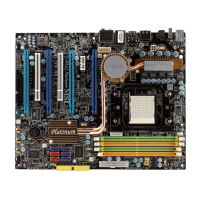
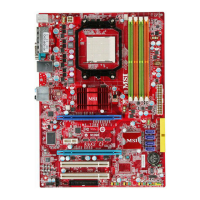
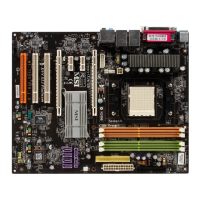
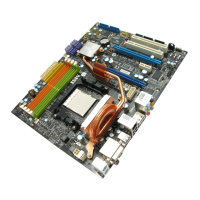
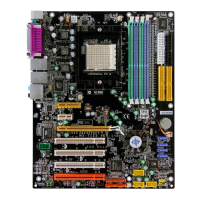

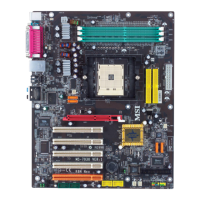
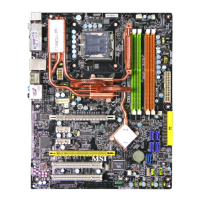

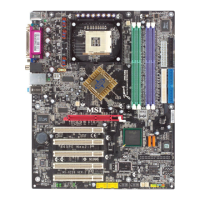
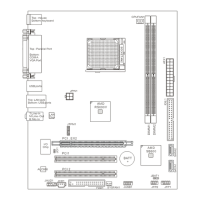
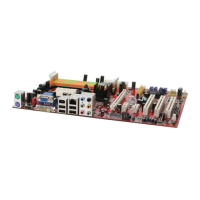
